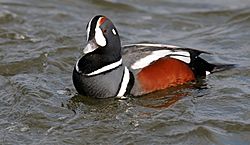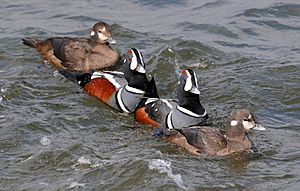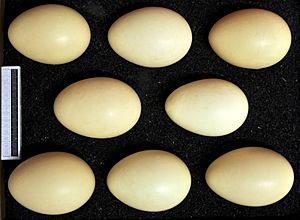Harlequin duck facts for kids
Quick facts for kids Harlequin duck |
|
|---|---|
 |
|
| Adult drake | |
| Conservation status | |
| Scientific classification | |
| Kingdom: | |
| Phylum: | |
| Class: | |
| Order: | |
| Family: | |
| Subfamily: | |
| Genus: |
Histrionicus
Lesson, 1828
|
| Binomial name | |
| Histrionicus histrionicus (Linnaeus, 1758)
|
|
The Harlequin duck is a special type of duck that loves living in the sea. These ducks are known for their amazing colors, especially the males. They are often found in cold, fast-moving water.
The male Harlequin duck has bright, eye-catching white markings. These markings help them blend in with their surroundings, like rippling water. This special way of blending in is called disruptive coloration. It makes it hard for other animals to see their true shape.
Contents
What Harlequin Ducks Look Like
Adult male Harlequin ducks are very colorful. Their heads and necks are a dark slate blue. They have a big white crescent shape in front of their eye. There's also a small white dot behind the eye. A larger oval spot is found on the side of their neck.
A black stripe runs over the top of their head. On each side of this stripe are chestnut (reddish-brown) patches. A white collar with a black border separates their head from their chest.
The rest of their body is a lighter slate blue. Their sides are chestnut colored. A white bar with a black border divides their chest from their sides. Their tail is black, long, and pointed. The inner wing feathers are metallic blue and white. Their bill is blue-grey, and their eyes are reddish.
Female Harlequin Ducks
Female Harlequin ducks are not as colorful as the males. They are mostly brownish-grey. They have three white patches on their head. One is a round spot behind the eye. Another is a larger patch from the eye to the bill. There is also a small spot above the eye.
Where Harlequin Ducks Live
Harlequin ducks breed in very cold, fast-moving streams. You can find them in places like north-western and north-eastern North America. They also live in Greenland, Iceland, and eastern Russia.
Their nests are usually on the ground. They are hidden well, often close to a stream. These ducks prefer areas with strong waves and white water.
Migration and Winter Homes
Harlequin ducks are short-distance migrants. This means they travel shorter distances than some other birds. Most of them spend the winter near rocky coastlines. They can be found on the Atlantic and Pacific coasts. It is very rare to see them in western Europe.
Protecting Harlequin Ducks
The number of Harlequin ducks in eastern North America is going down. They are considered an endangered species there. One reason for this is losing their homes due to hydroelectric projects. These projects build dams that change rivers.
Another problem is oil spills near the coast. These spills can harm or kill the ducks. People are working to protect their habitats and prevent oil spills.
How Harlequin Ducks Live
These birds are excellent swimmers and divers. They find their food by swimming underwater or diving deep. They also dabble, which means they dip their heads into the water to feed.
Harlequin ducks eat different kinds of small sea creatures. Their diet includes molluscs, like clams and snails. They also eat crustaceans, such as crabs and shrimp. In addition, they feed on insects.
Special Feathers
Harlequin ducks have very smooth feathers. These feathers are packed together tightly. This helps them trap a lot of air. This trapped air is super important! It keeps their small bodies warm in the chilly water. It also makes them very bouncy. After a dive, they pop back up to the surface like a cork!
Images for kids
See also
 In Spanish: Pato arlequin para niños
In Spanish: Pato arlequin para niños





